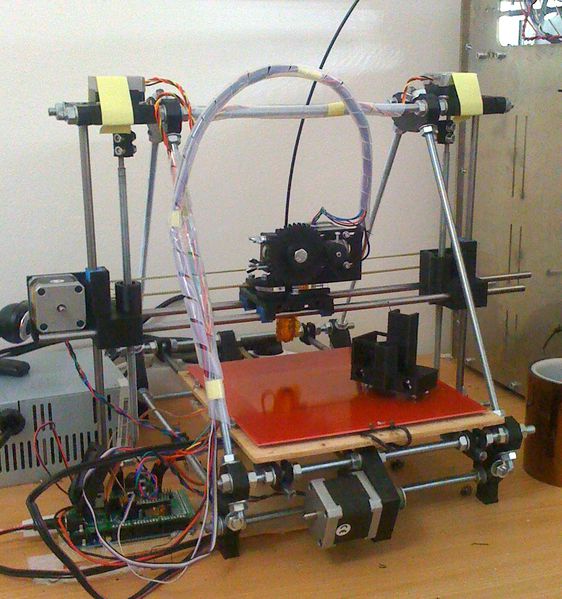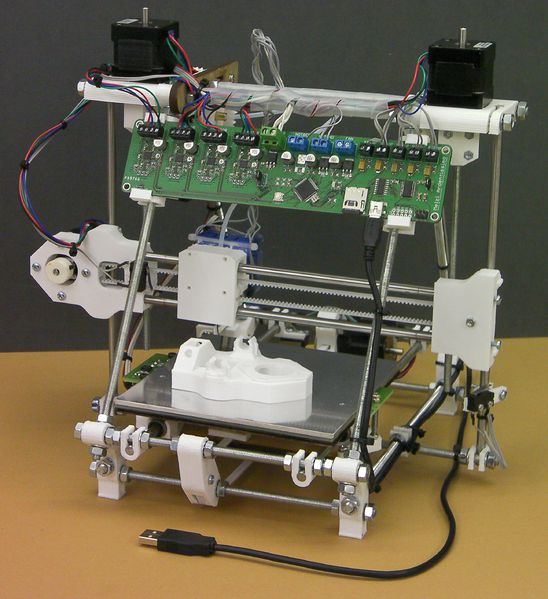Whether or not desktop 3D printing is the forerunner of the “third industrial revolution,” as Jeremy Rifkin and Chris Anderson have suggested, it’s definitely one of the hottest tech trends around. Open source DIY hacker engineers, artists, and craft designers have led the surge on the low end while higher-end models are already being used in rapid prototyping and short-run, custom manufacturing.
The market has been fueled by open source hardware communities, primarily the RepRap project and the MakerBot community. RepRap released its first open 3D printer kit design in 2007, inviting hackers and manufacturers to tinker with hardware and software. A RepRap-based industry has emerged almost as magically as the plastic objets that grow layer by layer in a 3D printer.
There are now over a dozen open source spinoffs of RepRap’s Darwin, Mendel, Prusa Mendel, and Huxley designs. The naming scheme reflects RepRap’s evolutionary model: A RepRap printer can fabricate its own plastic parts, fulfilling much of the project’s goal to be entirely self-replicating.
 RepRap Prusa Mendel
RepRap Prusa Mendel
End products range from art objects to plastic toys to parts for more complex devices like lamps and even a plastic housing for a Raspberry Pi. For those who dismiss 3D printers as just another craft craze that will generate mounds of plastic landfill, advocates point to the ability to use biodegradable plastics, as well as the targeting of niche markets with limited runs instead of creating plastic waste through volume manufacturing. Digital fabrication evangelists tout the technology as fostering a new, decentralized manufacturing ecosystem with faster time-to-market and support for more device customization.
3D Printers Grow Up
Since Linux.com reported on 3D printing a year ago, the industry has exploded. At the time, it was hard to find a preassembled open source 3D printer, but there are now over a dozen models available in both finished and kit form. Most are based on RepRap, but there are also some original open source designs ranging from the low-cost, $400-$800 Printrbot and Solidoodle printers to more feature-rich $1,400-$1,800 models like Type A and Ultimaker.
The open desktop models join a larger 3D printing market still dominated in revenues by proprietary, commercial vendors like Stratasys and 3D Systems, which sell higher end 3D printers and even pricier rapid prototyping and additive manufacturing equipment costing $50,000 and up. Stratasys developed the thermoplastic extrusion technology called Fused Deposition Modeling (FDM), which is used by RepRap and most other desktop printers. In this process, one or more types of plastic are heated and applied in layers via tiny nozzles until an object emerges.
The open hardware movement has turned the digital fabrication industry upside down, says Jarkko Moilanen, an open source community builder on projects including Meego, and the founder of the P2P Foundation funded research group, Statistical Studies of Peer Production. “The popularity of mostly open source, low-cost printers have forced the big players to lower their prices,” says Moilanen.
Last year, his organization published one of the first major research studies spanning both commercial and consumer/hobbyist 3D printing. Some 55 percent of the 384 3D printer owners who responded to the survey were involved in at least one open source project, and nearly 20 percent planned to in the future. Only 26 percent had no interest.
 RepRap Pro Huxley
RepRap Pro Huxley
The open model has helped to accelerate development on the low end far beyond what would likely have occurred under traditional market dynamics, suggests Moilanen. “The latest 3D printers have a lot better reliability, usability and ease-of use, and are almost ready for the masses,” he says.
The movement was fueled by the perseverance of RepRap and its volunteers, as well as “the growing variety of hackerspaces, which function as incubators,” says Moilanen. In addition, a number of projects came to life on crowd-funding sites like Kickstarter, and many more are in the queue.
Almost all of the new desktop 3D printers now offered by commercial vendors are proprietary, but the open source movement appears to be steering some toward more openness. On 3D Systems’ personal 3D printer page, which features its new Cube 3D printer, the company trumpets its upcoming “multi-front strategy to democratize access and accelerate the adoption of 3D printing for the student, the hobbyist and ultimately, the consumer.”
MakerBot’s Proprietary Reversal
So far, the most popular desktop 3D printer has been an original open source design based only loosely on RepRap: MakerBot’s Replicator. Much to the dismay of the open hardware community, however, in September, MakerBot announced that the Replicator 2 would be proprietary. The move was said to be in response to the arrival of an almost identical clone of the Replicator called the Tangibot.
Open source hackers argued that that the community was already successfully boycotting Tangibot for its abrogation of the FOSS credo of innovation. MakerBot may instead perceive that such community enforcement will lose effectiveness in a fast-growing market that is moving beyond hackers to a broader audience.
To be fair, MakerBot has not gone entirely proprietary, as the original Replicator is still open. MakerBot’s popular Thingiverse online store and hacker community remains free and open, unlike online retail stores for 3D printing designs like 3D Systems’ Cubify site.
In Statistical Studies of Peer Production’s survey of 358 3D printer users last year, about a quarter of respondents said they used RepRap devices, followed by about a fifth for MakerBot. These were followed by mostly proprietary commercial firms led by 3D Systems and Stratasys, each with about a fifth when you factor in their new subsidiaries, ZCorp and Object, respectively. The only other open source vendor on the list was Ultimaker, with less than 10 percent. In this year’s survey update, Moilanen expects to see a larger share for MakerBot, and perhaps the appearance of some other open vendors such as Printrbot.
While Moilanen believes that open source will continue to push desktop 3D printing, the field is growing so fast, he expects proprietary forces will emerge as well. “There will be more cases like MakerBot, with startups building products on open source and then turning closed source,” says Moilanen. “The 3D printing community is bound to mature gradually and find ways to deal with commercialism.”
Come back next week for our guide to open source and Linux compatible 3D printers.
Image Credits


